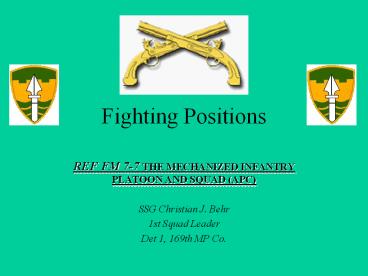Fighting Positions - PowerPoint PPT Presentation
1 / 24
Title:
Fighting Positions
Description:
Fighting Positions REF FM 7-7 THE MECHANIZED INFANTRY PLATOON AND SQUAD (APC) SSG Christian J. Behr 1st Squad Leader Det 1, 169th MP Co. General Whenever a dismount ... – PowerPoint PPT presentation
Number of Views:217
Avg rating:3.0/5.0
Title: Fighting Positions
1
Fighting Positions
- REF FM 7-7 THE MECHANIZED INFANTRY PLATOON AND
SQUAD (APC) - SSG Christian J. Behr
- 1st Squad Leader
- Det 1, 169th MP Co.
2
General
- Whenever a dismount team dismounts to conduct the
defense, it prepares fighting positions. A
well-built fighting position gives the defender a
marked advantage over the attacker and enhances
his weapons firing capability. Fighting
positions must provide cover and concealment
against aerial and ground fire and observation,
and provide for mutual support among fighting
positions observation and fields of fire.
3
COVER
- Protect the firing team
- Thick enough in front, rear and flanks and
overhead - provide cover to shoot to the oblique, if under
fire to the front
4
FRONT AND OBLIQUE
- Cover should be at least 18 inches of dirt to
stop small arms. - shooting oblique requires that the cover be long
enough for two men and hide the muzzle blasts of
their rifles.
5
CONCEALMENT
- Readily available
- will not attract enemy attention
- need not be replaced
- make it hard for enemy to see
- conceal from enemy aircraft
6
FIGHTING POSITIONS
- Hasty fighting position
7
FIGHTING POSITIONS
- One man position Two-Man Position.
8
FIGHTING POSITIONS
- Modified Two-Man Position
9
FIGHTING POSITIONS
- Steep Terrain
10
PREPARING FIGHTING POSITIONS
- Dig a fighting position armpit deep to lower the
profile of the occupant(s) and still let him
shoot his weapon.
11
PREPARING FIGHTING POSITIONS
- Provide support by having a distance between the
hole and the frontal cover that should be enough
to let a soldier shoot from a supported position
(elbows on the ground).
12
PREPARING FIGHTING POSITIONS
- Dig elbow holes that serve to stabilize the
shooters arms and lower is profile - Dig trenches for the bipod legs of an automatic
rifle to get it close to ground level - Use aiming stakes to help a soldier fire his
rifle on dangerous approaches at night
13
PREPARING FIGHTING POSITIONS
- Use sector stakes, right and left, to define the
sector of fire. They prevent accidental shooting
into adjacent positions. A soldier should not
let takes spoil his positions concealment.
14
(No Transcript)
15
PREPARING FIGHTING POSITIONS
- Shape the floor of the hole so that it slopes
toward the grenade sumps. Water will run into the
sumps, and grenades will tend to roll into them. - Dig two trench-shaped hand-grenade sumps at each
end of the position. The trenches should be dug
as wide as the blade of an intrenching tool, at
least as deep as the intrenching tool, and as
long as the position is wide. The slope of the
floor should channel grenades thrown into the
position into one of the sumps.
16
(No Transcript)
17
PREPARING FIGHTING POSITIONS
- Building overhead cover
- protect from airbursts shell fragments
- use logs, 4 to 6 inches on top of each other
along the entire length of the frontal and rear
cover - high enough so that men can shoot beneath when
complete - room for night vision and other devices
18
Base is made of logs, 4 to 6 inches placed side
by side across supports
19
Water repellent layer, such as packing material
from dragon rounds is then laid over the logs.
About 6 to 8 inches of dirt is added
and molded to blend with the slope of the
terrain. And finally, the overhead cover is
camouflage. When it is complete, the man in the
position will have protection from shell
fragments and still be able to shoot.
20
When overhead cover would make a position easy to
see, it can be built off to both flanks. When
flank overhead cover is used, only one grenade
sump is dug in the center of the floor against
the back wall.
21
- After removing sod and 25 to 35 centimeters (10
to 14 inches) of dirt, 10 to 15 centimeters (4 to
6 inches) of supporting logs or planks are laid
across that place to support the rest of the over
head cover material
22
- The logs are covered by piling on them 15 to 20
centimeters (6 to 8 inches) of dirt. Sod is used
to camouflage the dirt. It all must look natural.
23
Revetments
- Revetments are supports put against the sides of
a fighting position to keep them from collapsing.
Revetting is necessary when positions are dug in
loose or wet soil. Anything that will hold in the
walls (wire, boards, logs, etc.) can be used to
revet as long as it is staked and anchored. After
anchor lines are attached, stakes are driven all
the way into the ground. That hides them so they
will not be mistaken for aiming or sector stakes.
24
FIGHTING POSITIONS REF FM 7-7 ANY QUESTIONS????































